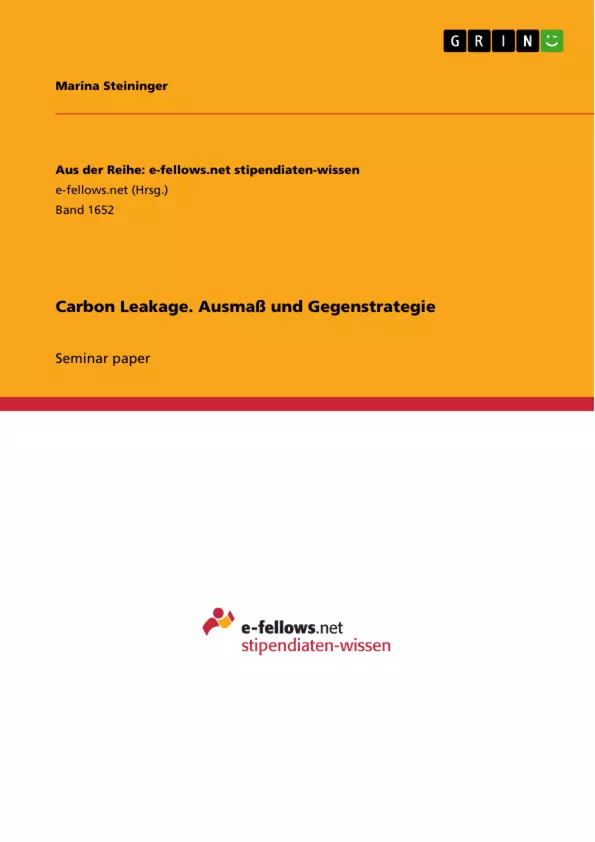This paper is a literary based economical analysis of the problem carbon leakage, its extent, arising consequences and possible counter strategies.
Today plenty of research on carbon leakage is available. It includes, to name just a few, analyses on influences and extent of carbon leakage (Aichele (2013), Paroussos et.al., (2014), Aiginger, (2013)) and research of first and second-best solutions and possible counter strategies (Aichele (2013), Aroyo-Curras et.al., (2013), Görlach, et.al., (2008)). The purpose of this paper is to investigate extent and counter strategies of carbon leakage.
The current climate development is illustrated in the first passage. A brief description is important for efficient subsequent analysis. Following this summary, two major climate actions are introduced in chapter two: the Kyoto Protocol and the European Emissions Trading System. As a consequence of the implementation of unilateral climate approaches, the problem Carbon Leakage arises. When industrialised countries and specifically Europe introduces strict emission standards, costs of production of emission intensive industries rise. As a result of policies like carbon taxation, or the European emissions’ pricing system those companies relocate parts of their sectors in countries without high standards. As a consequence the overall emissions might increase.
After substantiating the dilemma of efforts concerning climate actions, the actual extent of carbon leakage will be illustrated in chapter three. For this, Aichele (2013) is the main source for empirical proof.
Arguments to internalise carbon leakage efficiently are investigated in chapter 4 and 5. Solving the carbon leakage problem will not thoroughly contribute to actual climate goals of the European Union. This paper highlights the importance to concentrate not just on this problem but to tackle down emissions’ reduction and carbon leakage in Europe at the same time. Hence several possibilities of policy tools are introduced.
It is substantiated that they might work best if you combine them, because each has advantages and disadvantages and addresses different problems. As long as no multilateral approach is implemented, WTO conform border tax adjustments, carbon taxation of domestic production and fostering investment incentives for new energy saving production are illustrated as one possibility to internalise both carbon leakage and an actual reduction of emissions.
Inhaltsverzeichnis (Table of Contents)
- Emissions: Facts, Development and Consequences
- Effort to reduce emissions
- Kyoto Protocol
- Europe's Climate Action
- Extent and consequences of Carbon Leakage
- Carbon Leakage - Reasons of emergence
- Consequences and extent of Carbon leakage
- Counterstrategies against Carbon Leakage
- Multilateral approaches
- Unilateral Approaches
- Free allowances of emission rights
- Border Tax Adjustments
- Carbon Taxation
- A complementing incentive scheme
Zielsetzung und Themenschwerpunkte (Objectives and Key Themes)
This paper provides an in-depth economic analysis of carbon leakage, exploring its extent, arising consequences, and possible counterstrategies. The study examines current climate developments, introduces major climate actions like the Kyoto Protocol and the European Emissions Trading System, and delves into the problem of carbon leakage arising from unilateral climate approaches.
- Carbon leakage: its causes, consequences, and extent
- Counterstrategies to mitigate carbon leakage
- The effectiveness of different policy tools in addressing carbon leakage
- The importance of combining policy tools to achieve climate goals
- The role of multilateral approaches in tackling carbon leakage
Zusammenfassung der Kapitel (Chapter Summaries)
- Chapter 1: Emissions: Facts, Development and Consequences This chapter discusses the alarming rise in CO2 emissions since 1990 and provides insights into the future development of emissions, highlighting the increasing energy demand and the major contributors to emissions like China and the United States. The chapter emphasizes the urgent need for ambitious climate policies to prevent further increases in greenhouse gas emissions.
- Chapter 2: Effort to reduce emissions This chapter introduces two major climate actions: the Kyoto Protocol and the European Emissions Trading System. It outlines the aims and mechanisms of these initiatives to reduce emissions globally and within the European Union.
- Chapter 3: Extent and consequences of Carbon Leakage This chapter defines and explains the phenomenon of carbon leakage, detailing the reasons for its emergence and analyzing its potential impact on overall emissions. It draws upon empirical data to illustrate the extent of carbon leakage and its consequences for climate goals.
- Chapter 4: Counterstrategies against Carbon Leakage This chapter explores various approaches to address carbon leakage, examining both multilateral and unilateral strategies. It delves into the effectiveness of different policy tools, including free allowances of emission rights, border tax adjustments, and carbon taxation.
- Chapter 5: A complementing incentive scheme This chapter presents a comprehensive incentive scheme that combines various policy tools to effectively tackle carbon leakage and achieve climate goals. It argues for a multi-pronged approach, considering the advantages and disadvantages of each policy tool.
Schlüsselwörter (Keywords)
This paper focuses on the key terms and concepts related to carbon leakage, including climate change, greenhouse gas emissions, Kyoto Protocol, European Emissions Trading System, carbon pricing, competitiveness, relocation, border tax adjustments, carbon taxation, and incentive schemes.
- Citar trabajo
- Marina Steininger (Autor), 2015, Carbon Leakage. Ausmaß und Gegenstrategie, Múnich, GRIN Verlag, https://www.grin.com/document/311107



